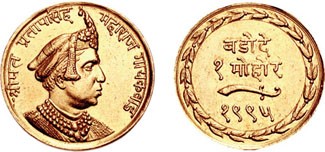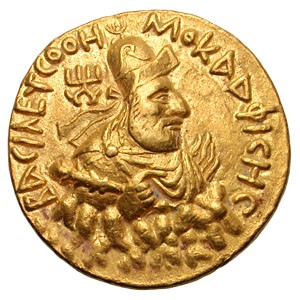Coins of Deccan & Maratha Rulers
Deccan, the word derived from Sanskrit language, Dakshin, which means South (it became Dakkhan in local language), was a large south-western-central part of the Indian subcontinent, renown for the rugged landscape, ancient forts and hardy people. The first reference to this region can be traced back to reign of Mauryan Emperor, Ashoka, who ruled in 2nd century BC. It is inscribed in his rock edicts that he sent his missionaries to the Rashtrikas, the dwellers of Dandaka forest. This region is now split into 3 modern states, Maharashtra, Northern Karnataka and Telangana/Andhra. The inhabitants were fierce independent minded people, who called themselves Maha-rashtrikas and in course of time, the country that they occupied came to know as Maharashtra (Maha means great, Rashtra means country). For the sake of simplicity, all the following dynasties which ruled in the Maharashtra, Karnataka, Andhra/Telangana states of modern India have been categorized as the Deccan dynasties (after all, the states have been formed 75 years back while these dynasties ruled more than 1000 years back).
The Deccan saw emergence of multiples illustrious dynasties including Satvahanas, Chalukyas, Yadavas and finally the Marathas. Marathas were the single most formidable power who made a successful attempt for the supremacy of the Indian subcontinent on decline of Mughals in eighteenth century. I have included coins of all of these dynasties.
The Early Chalukyas (of Vatapi) or Eastern Chalukyas
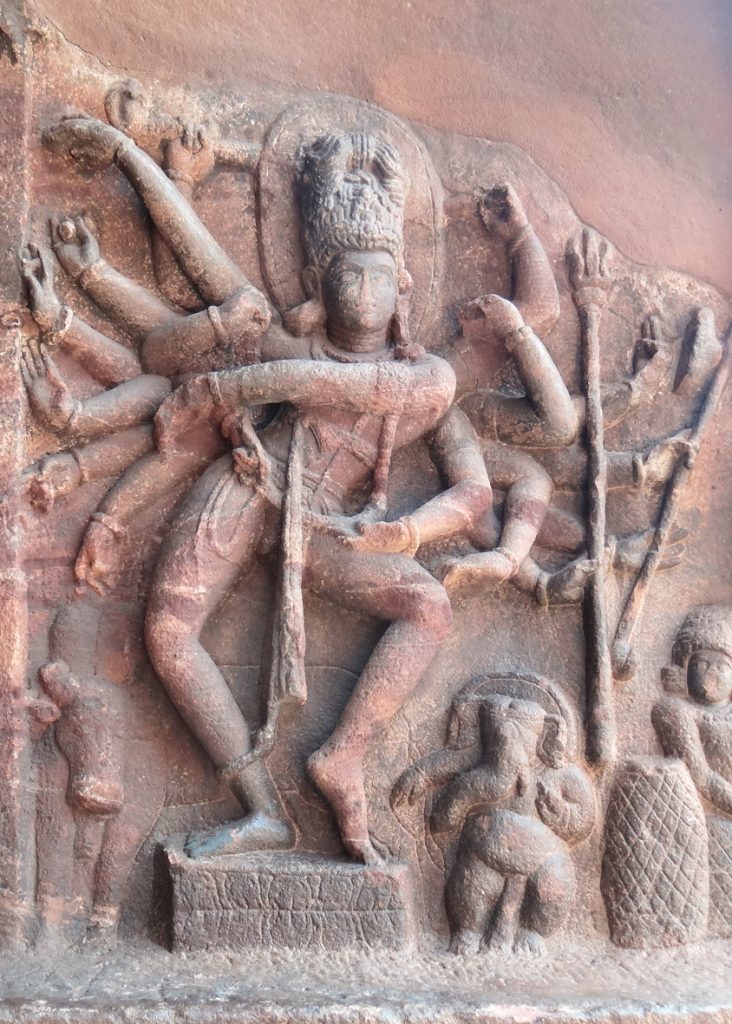
The first ancient dynasty of Deccan was Satvahanas, and their rule lasted for almost four centuries. Many kingdoms arose in the ruins of Satavahanas. One of the major kingdom was the Chalukyas, who initially replaced a major power of Andhra region, Chutus of Banavasi (Vaijayanti) and rose to prominence in 6th century AD. Like Satvahanas, Chalukyas too occupied a vast territory covering entire Deccan region, modern Maharashtra, Karnataka and Andhra/Telangana states.
Pulakesin I was the founder of Chalukya dynasty whose capital was located at Vatapi (modern Badami in northern Karnataka). His grandson Pulakesin II was the most famous king of this dynasty. During his long reign of 33 years (609 to 642 AD), he extended his kingdom from Narmada to Kaveri river thus occupying best of Deccan, reviving glorious days of Satavahana king, Gautamiputra Satakrni. He was the only king who successfully repulsed the great king of Kannauj, Harshavardhana. Ambitious Chalukyas now were eyeing the southermost part of India and thus came into direct conflict of another great dynasty of south, the Pallavas of Kanchipuram (located in modern Tamilnadu). There were numerous wars for supremacy for the Deccan-southern India. Pulakesin’s great-grandson Vikramaditya II finally defeated Pallavas and entered in their capital, thus becoming master of entire south India.
But soon after his death, in 753 AD, his son was overthrown by Dantidurga, a king of Rashtrakuta dynasty, who had small kingdom (in northern Deccan). Thus, after almost two centuries of rule, this Early Chalukyan dynasty (of Vatapi) rule came to an end. However, after demise of Rashtrakutas, Chalukyas rose again, and commonly known as Western Chalukyas.
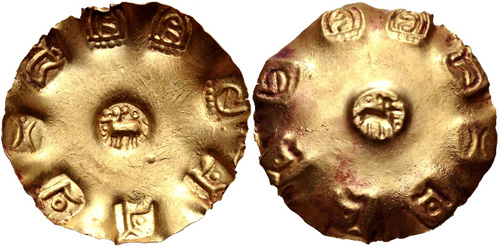
Eastern Chalukyas or their successors (Uncertain ruler)
10th century AD (?)
Gold, Pagoda
Obverse: Series of Telugu-Kanerese punchmarks around the central punchmark depicting Lion looking left
Weight: 3.69 gms
Reference: CNG Auction 232, Lot 477
Very Rare
There is a possibility that the first gold coins were introduced in south India by Chalukyas. These are the rare coins and due to lack of inscriptions, often difficult to assign to any specific rulers. Chalukyan rulers minted two distinct types of coins:
1. Punch-Marked gold coins
2. Die-Struck gold coins
Punch-marked gold coins: Eastern Chalukyas were the first who minted the punch-marked gold coins. Unlike, the die struck coins struck by their contemporary rulers of north and central India (the post-Gupta dynasties), Chalukyan rulers minted both the types. Punch-marked coins silver coins were introduced to south India during late Mauryan period and remained mainstay of economy for many centuries. What made Chalukyas to issue punch-marked gold coins is debatable. Possibly, the concept of die struck coins had not become popular as yet in south India and easy availability of gold, which was mined in their kingdom (especially the riverbeds of Karnataka region) in ample quantity and the scarcity of silver, could have been the two major factors. These are rare gold coins of ~3.7 gms, which were later adopted by various kingdoms of south India, including those who acknowledged suzerainty of Chalukyas. These gold coins are broad and circular in shape with various punches at the edge and a central punch depicting a Lion (shown above).
Die Struck coins: The die-struck coins of Chalukyas are special; these gold coins depicting Varaha or Wild boar, representing Varaha avatar of Lord Vishnu became synonymous with the gold coins of south India. The Varaha was the Lanchhana or royal emblem of of Early Chalukyas and was used by later Chalukyas (Western) too on their coins. Varaha can be seen in the sculptures of rock cut temples of Aihole, patronized by Chalukyas. Indeed, contemporary literature cites the gold coins of south India as Varaha, which obviously derive the name from Chalukyan coinage. Shown below is the possibly the first gold coin of south India, the Varaha.
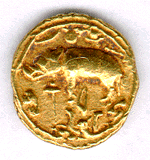
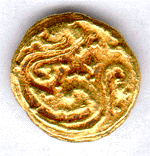
Chalukyas of Vatapi (Likely to be Vikramaditya II)
733-744 AD AD
Gold Die-Struck Pagoda or `Varaha’ (the real one!); Weight: 3.88 gms; THE FIRST GOLD COIN OF SOUTH INDIA
Obverse: Caparisoned Varaha, the Boar and lampstand. The sun and moon shown above, the conch shell in front
Reverse: Artistic scrollwork (derived from Virupaksha temple of Pattadakal, shown on right)
Reference: Similar to Mitchiner1998:268, Chattopadhyaya#107
Extremely Rare, probably Unique

Shown above is the die struck coin, the obverse of which shows a large caparisoned boar or Varaha. Above the Varaha is a pellet and crescent, representing sun and moon. Near the neck of Varaha is a lampstand. Although all the three royal families, Eastern Chalukyas, Chalukyas of Vengi and Western Chalukyas have been known to mint coin depicting Boar, the Eastern Chalukyas were the only who showed Varaha along with a lampstand, which was their royal emblem. This royal emblem with Chakra and conch shell, is carved in the Ladkhan temple at Aihole (shown below). This temple, dedicated to Lord Vishnu, is the oldest free-standing temple of south India, build by Eastern Chalukyan rulers in 5th century. This Chalukyan royal emblem is also reproduced, complete with sun and moon above the Varaha and the lampstand, at Government Museum, Chennai (shown below).
It is likely that this coin was minted by Vikramaditya II (733-744 AD), who defeated Pallavas and entered their capital. He was mesmerized by the beautiful temple of Kanchipuram. Once back, he instructed the building of a temple that blended northern Nagara style and southern style of temple architecture, resulting in one of the finest temple of south India, the Virupaksha temple at Pattadakal. His inscription has survived, which indicates that his queen. Lokamahadevi built this temple to commemorate his victory over Pallavas, in 740 AD. This temple has some spectacular artwork, including ornately carved windows. The artistic scrollwork seen on the reverse of the Vikramadity’s coin appear to be inspired from the window on the western wall of this temple, between two sculptures of Shiva (see above). On left of the window is Lord Shiva with Parvati and on right is Natya Shiva, the dancing Shiva with Apasmara, a dwarf demon that represents ignorance. Vikramadiya has been victorious in many battles and his victory against Pallava king fetched him a massive was booty. It is likely that this financed the Virupaska Temple construction, followed by large donations to temple Brahmins. Could this be one of those specimen?
The ornamental scrollwork shown on reverse of the coin became a signature of Chalukyan rule. And after their fall, one of the dynasty that rose in this region, Gangas of Talakadu, continue to have this scrollwork on reverse of their coins, however with the new obverse, the caparisoned elephant, which too were inspired from temples of Talakadu!. See coins of Gangas of Talakadu in southern Indian section.
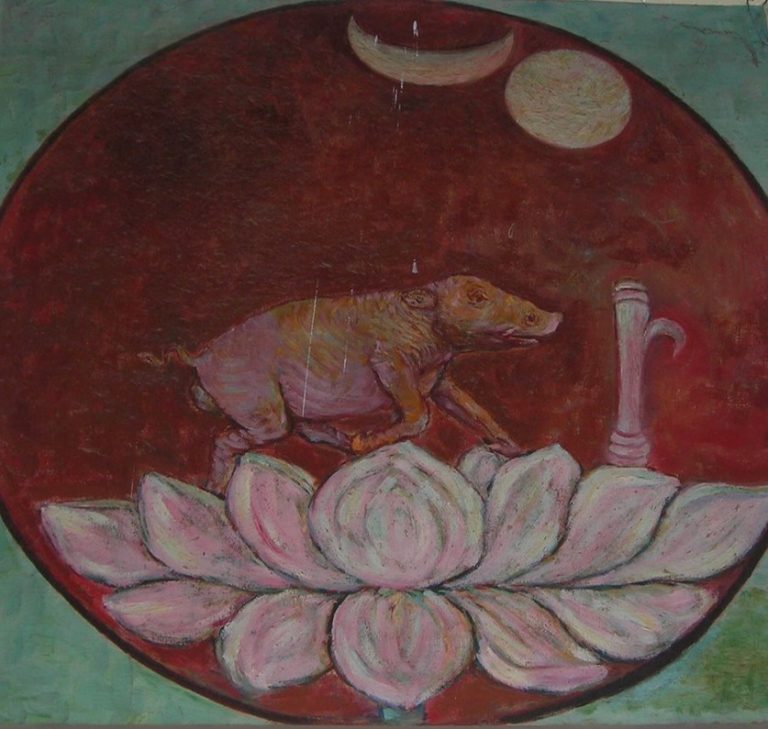
Chalukyas of Vatapi Emblem at Museum at Madras (Chennai)
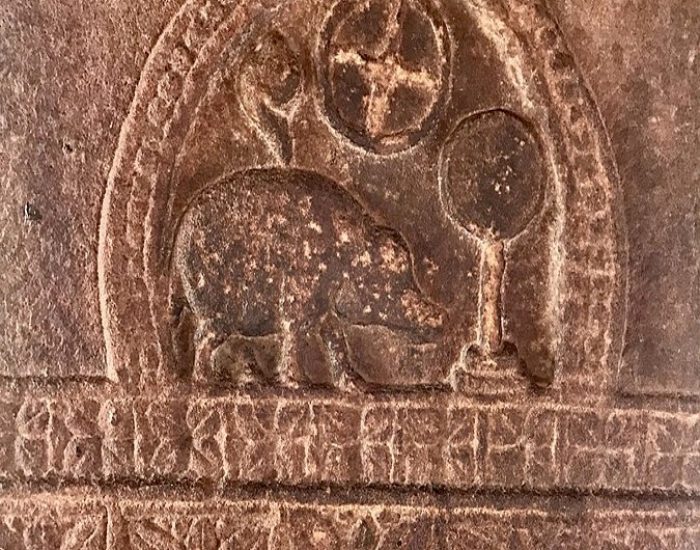
Chalukyas of Vatapi Emblem at Ladkhan Temple, Aihole
The Western Chalukyas (of Kalyani)
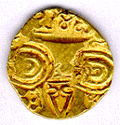
Jayasimha II Jagadekamalla
1015-1042 AD
Gold, Bhairava Gadyana, Uniface
Obverse: Seven punches, two Sri, one `Spearhead’ and Telugu-Kanerese inscription Bhirava
Weight: 3.72 gms
Reference: ONS Newsletter#160
Extremely Rare
Taila (973-997 AD), a descendent of Early Chalukyas was the founder of the second Chalukya dynasty, commonly referred as Western Chalukyas. His capital was located at the Manyakhet (modern Malkhed in Northern Karnataka). This dynasty was contemporary of Cholas and thus started the long battle of supremacy for south India between these two dynsties. His grandson Jayasimha II Jagadekamalla repelled invasion by Rajendra Chola in 1018 AD from south and also defended his kingdom from northern invasion. He later transferred his capital from Malkhed to Kalyana (or Basavakalyana) in modern Karnataka. Jayasimha was an able ruler and was followed by his equally brave son, Someshwara I (1043-68), who took a title of Trailokyamalla. Rajadhiraja Chola mounted an expedition against Chalukyas in 1045 AD and later captured their capital Kalyana. Someshwara retaliated and expelled Rajadhiraja. Eventually, by the end of 12th century AD, the sovereignty of entire south India was shared between Vikramaditya VI of Chalukya dynasty and Rajendra Chola (III) Kulottunga I.
Similar to their Eastern predecessors, Western Chalukyan coinage can also be divided into two distinct types:
1. Punch-marked gold coinage.
2. Die Struck gold coinage.
The gold punch-marked coins, first introduced by Eastern Chalukya (of Vatapi) rulers, were reintroduced by Jayasimha II Jagadekamalla. These type were used by various kingdoms of south India, including those who accepted suzerainty of Chalukyas, the most notable among those were the Kadambas of Hangal and Goa. Shown above is an excellent and extremely rare example of a medieval punch-marked gold coin of southern India ( article published in ONS newsletter No. 160). This is an uniface gold coin with seven punches, four of which are prominent while three are partly struck at the border of the coin. The two prominent punch marks create two Sri alphabets in Telugu-Kanerese. The third punch mark corresponding to a triangular motif, represents spearhead. The fourth punch mark represents Telugu-Kanarese inscription which reads Bhairava. Two marks at the lower corners represent lions (stylized) while the seventh punch mark at the lower left corner perhaps represents sun and moon.
The common gold coins of south India were known as Varaha and Gadyana. Both represents the same gold coin weighing approximately 3.2 to 3.36 gms (about 50-52 grains). The term Gadyana has been used to represent a gold coin of 48 rattis or approximately 5.2 gms in a famous book Lilavati, written by Bhaskaracharya. No coin type is available today which exactly corresponds to the standard of Lilavati. The term Gadyana has been referred first in AD 733 and was continued to be referred in inscriptions of Rashtrakutas, Gangas and Eastern Chalukya dynasties of south India. Gadyana has also been referred in inscription of Northern India where it was a gold coin weighing about 4.01 gms (32 gunjas or 62 grains).
Most likely the coin shown above is a Bhairava-gadyana minted by Jayasimha II Jagadekamalla. He has minted coins of very similar fabric and weight, which depict triangular motif, attributed as spearhead. His coinage can be easily attributed due to the presence of legends like Jagadeka or Jagadeva or Jaya on those coins. Possibly, in the same tradition of earlier south Indian dynasties, Rashtrakutas, Gangas and Eastern Chalukya, Jayasimha II Jagadekamalla too minted a gold coin called Bhairava Gadyana, with distinct punch-mark of his own dynasty, a spearhead.
Shown below is another beautiful example of Jayasimha’s punch marked coin which show series of punchmarks with central punch mark of Lion with raised right paw. The surrounding punchmarks show 4 lions, two `Sri’ and two punchmarks with partly visible Telugu-Kanarese legends
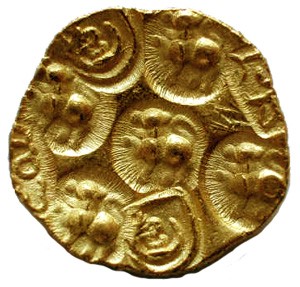
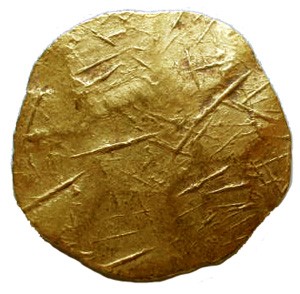
Jayasimha II Jagadekamalla
1015-1042 AD AD
Gold, Pagoda, Weight: 3.9 gms
Obverse: Nine punchmarks; 4 Lions, 2 Sri, 2 punchmarks with Kannada legends and central punchmark showing Lion
Reverse: Uniface
Reference: Similar to Mitchiner1998:311
Rare
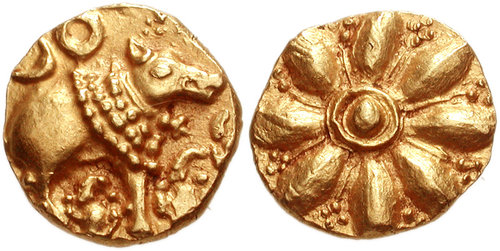
Someshwara I (?)
1043-1068 AD
Gold, Varaha
Obverse: Caparisoned Varaha looking right
Weight: 3.8 gms
Reference: CNG 142, Lot 218
Very Rare
Shown above is the die struck coin, possibly minted by Someswara I. Someshwara conquered Vengi in 1049 AD and issued a series of gold coins. Some of the coins of similar type bear legend Sri Venga Vadi Gonda, the conqueror of Vengi. The obverse shows a large caparisoned boar or Varaha. Above the Varaha is a pellet and crescent, representing sun and moon. Someshwara’s son Vikramaditya VI (1076-1127 AD) was a famous king of Chalukyan dynasty. He started a new era replacing old `Shaka’ era. His reign is landmark in history of Hindu Law. The great jurist Vijnaneshwara was patronized by him. Celebrated author Bilhana who wrote Vikramadeva-Charita was also in his court. He also known to have patronized numerous poets. His son and successor Someshvara III (1126-1138 AD) was also a writer of repute. After death of Someshwara III the Chalukyan rule started it’s decline. After two centuries, in 1190 AD this dynasty disintegrated and their territory was divided among three separate Kingdoms: Hoysalas of Dorasamudra, Kakatiyas of Warangal and Yadavas of Devgiri. Hoysalas occupied the majority of Karnataka region, Kakatiyas occupied Andhra Pradesh, while Yadavas occupied Western Maharashtra.
Kalachuris of Kalyani
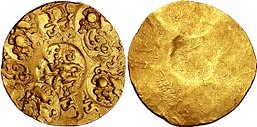
Bijjala Kalachuri
1156-1168 AD
Gold, Pagoda; Weight: 3.38 gms
Obverse: Nine punchmarks- 4 Lions, 2 Sri and 2 puncharks with Kannada legend `Suba’, with central punchmark of Anthropoid Garuda running right with Serpant in his hand
Reverse: Uniface
Reference: Mitchiner1998:278-79
Extremely Rare
The Kalachuris of Kalyana was a short lived dynasty that started as feudatories of Western Chalukyas. The Kalachuris of Kalyani may have origin in central India and could have been related to other central Indian dynasty, Kalachuris of Tripuri/Dahal (see the other section) and might have migrated to south and became vassals. Later a viceroy named Bijjala took over from the Chalukyan king, Taila III. He ruled over the Deccan region of modern Maharashtra and northern Karnataka. However, his successors were defeated by Chalukyan king Mangaleshs, who wrested back the control of capital city Kalyana and the kingdom.
Even though the rule of this dynasty was short, it left significant mark on history of Deccan. Saint Basavanna (Basaveshwara) was likely to be the statesman in Bijjalla’s court, and is credited with starting a new sect in Hinduism, called ViraShaiva (followed of Lord Shiva). The followers of the sects are often identify themselves as Lingayats. Shown above is Bijjala’s gold coin which is a punchmarked type, heavily influenced by Chalukyan punchmarked variety of Jayasimha, shown above. It too has nine punches with a central punch showing anthropoid Garuda (mythical eagle) holding serpent in his raised left hand. The central punch is surrounded by eight punches, 4 showing lion, two Sri and two with Kannada legend Suba.
Yadavas of Devgiri
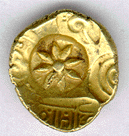
Ramachandra
Yadava Dynasty, 1270-1311 AD
Padmatanka, Weight: 3.8 gm, Gold
Obverse: Lotus in center, Sri, Conch, legend in Devnagri SriRaMa, Trident (Trishul) below the legend, Uniface
Reference: Mitchiner1998: 289 or MAC#644-645
Extremely Fine, beautiful
Yadava dynasty is also known as Seuna dynasty due to their origin from Seunapura (modern Sinnar, near Nashik), where the Gondeshwar temple built by this dynasty, has survived. Bhillama was the founder of Yadava (also known as Jadhav in Marathi) dynasty, although it was his grandson Singhana (Simhana or Singaldev; literally means Lion), who made it the premier kingdom of Deccan. Singhana was a patron of learning and literature and established the college of astronomy to study the work of celebrated astronomer, Bhaskaracharya. We can read about his magnanimous donations, which are carved in stone (written in earliest Marathi language) slabs in the temple of Goddess at Kolhapur in Maharashtra. Composition of famous works of scholars like Hemadri or Hemadpant (who was responsible for introducing a style of architecture also called Hemadpanthi), Bopadeva and Dhnaneshwar (a prodigy who at the age of 16 translated Bhagavat Gita from Sanskrit to Marathi, perhaps the best and sweetest poetry ever written in Marathi) were composed during reign of Yadava dynasty.
Yadavas ruled present day Maharashtra and Karnataka states of India. They had capital at Devagiri fort (means the mountain of gods, also known as Daulatabad), possibly the strongest fort of India. It is the best example of medieval fort building style. In spite of it’s strength, it fell to the first invasion of southern India; in 1294, Allauddin Khilji captured the fort defeating Yadava king Ramchandra. Khilji extracted massive amounts of gold and precious metals from Devagiri ruler, which paved way for his ascent on Delhi throne. Soon, in 1312 his general Malik Kafur again invaded Devagiri, under pretext of sheltering the defeated Vagela ruler, Karnadeva and his daughter, DevalaDevi. Ramachandra once again sued for peace and effectively became the Khilji vassal.
Shown above is the nice example of a gold coin, commonly called as PadmaTanka, issued by Ramachandra Deva. It is a punchmarked coin with central punch showing lotus (Padma means lotus, hence the name), which is surrounded by 4 punches, depicting conch shell, Sri (twice), legend in Devanagri Sri Rama with `Trishul” (trident) below the legend.
Although sovereignty of Yadavas was lost, the dynasty continue to rule for another 15 years. Ramachandra’s successor Singhan III was the last great king of this dynasty, who challenged Khilji overlordship, although fought bravely, died fighting. The Devgiri kingdom was incorporated in Delhi Sultanate. Shown below an interesting coin minted by Singhan III, which he minted jointly with his queen Kamvaladevi (Kavaladevi or Kamaladevi), a rarity in medieval time. The obverse shows Yadava emblem, a sword/dagger flanked by conch shell and Chakra (two representations of Lord Vishnu). The reverse shows the Devanagri legend, Sri Singhan Kavaladevi. Another interesting aspect is a classic change of minting style that one can see clearly; unlike the punchmarked coinage, Padmtanka, shown above which has five punches, minted by the early Yadava rulers, this is a classic Die-struck coin, minted by the late Yadava ruler.

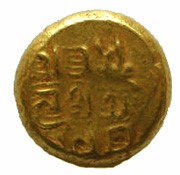
Singhan III (with queen Kamvaladevi)
Yadava Dynasty, 1315-1318 AD
Pagoda, Weight: 3.8 gm, Gold
Obverse: Sword flanked by conch shell and chakra
Reverse: Devanagri legend, Sri Singhan Kavaladevi
Reference: Mitch K&A 306-7
Bhonsale of Pune
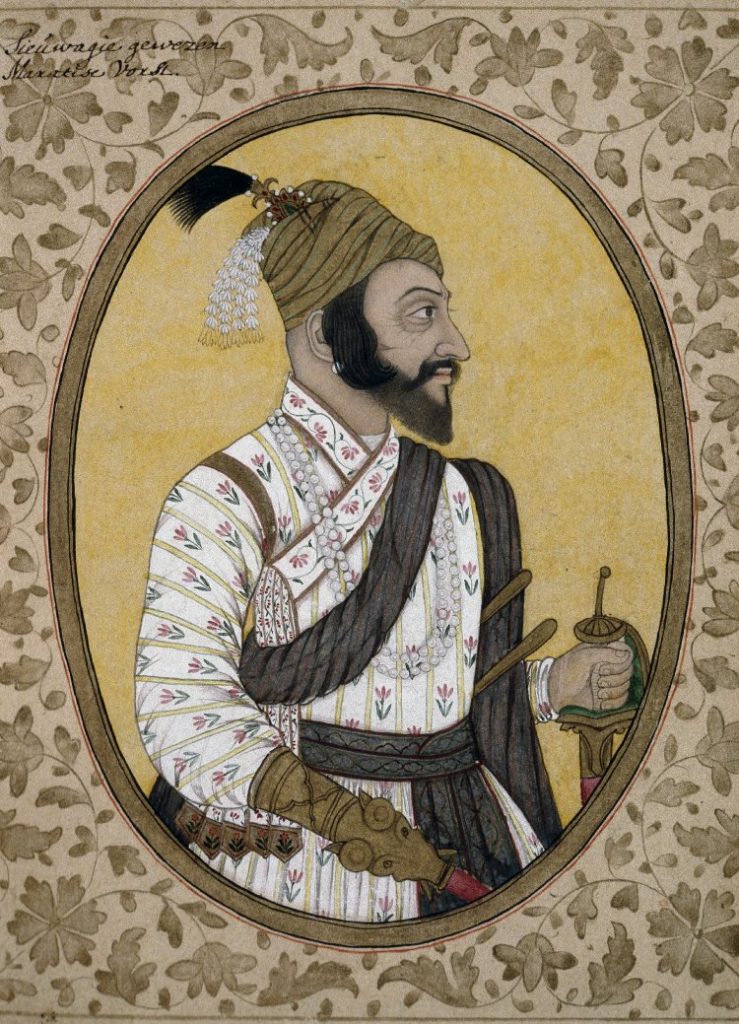
The rise of the Maratha power was an important factor in Indian politics during seventeen century. After fall of Kingdom of Yadavas to Allauddin Khilji, they lost their independence but acquired political and military experience for next few centuries by serving under various sultanates of Deccan. In seventeen century Shahaji Bhonsale, a gallant and capable soldier rose to distinction and acquired 3 fiefdoms, one each in western Maharashtra (Pune), Karnataka (Bangalore or Bangluru) and in Tamilnadu (Tanjavur). He even played as a Kingmaker in Ahmadnagar Sultanate, the Nizam Shahi rule of Deccan. He married Jijabai, hailed from the royal family of Yadava (Jadhav) kings of Devagiri. Her son, Shivaji was the hero of Maratha national unity whose glorious achievements have influenced post-Mughal Indian history considerably.
Shivaji was born at Shivneri fort in 1627 (according to some historians 1630 AD or 1686 Samvat). Shahaji gave part of his `Jagir’ or fiefdom (included Pune, Supe and Chakan) to his wife Jijabai and son Shivaji. Jijabai was a lady of extraordinary intellect and was solely responsible for fashioning Shivaji’s career as the independent King in Mughal dominated Indian scenario.
Shown on left is the Portrait of Shivaji; painting mounted onto an album folio, located in the British museum. The Album contains 26 paintings of Indian princes/rulers of Mughal era, made with Ink, opaque watercolour and gold on paper. It is dated 1680-1687 and has the German Inscription (top left) `Sieúwagie gewezen/Maratise Vor Sl‘. The inscription identifies the subject and means: ‘this was Shivaji, founder of the Maratha state.’
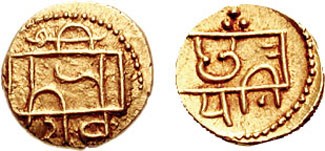
Chatrapati Shivaji Bhonsale
1630-1680 AD / Reign 1674-1680 AD
Hon, Weight: 2.87 gms, Gold
Obverse: Legend in Devnagri `Shri Raja Shiva’.
Reverse: Legend in Devnagri `Chatrapati’.
Reference: MW T1; CNG Specimen, Auction 69, Lot 2022 & Auction 73, Lot 1186
Rare
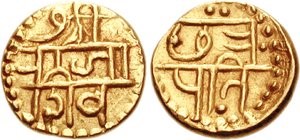
Shivaji at very young age realized the importance of guerrilla warfare and taking advantage of growing weakness of Deccan sultanates, seized many forts in western Maharashtra and later annexed small Maratha principality of Jawali. Later in daredevil act, he killed Afzal Khan, the most powerful noble and general of Bijapur court. He came in direct conflict with Mughal emperor Aurangzeb, who never trusted Shivaji. He sent his able general and governor of Deccan, Shaista Khan. After two years of sporadic fighting, one night Shivaji secretly entered into Shahista Khan’s palace, slew his son, his 40 bodyguards and personally attacked Khan. Khan barely escaped with his life by jumping out of the window, but during this escape lost his thumb and two fingers, chopped by Shivaji’s sword. This daring attempt on the life of Mughal viceroy, who was also Emperor’s uncle, immensely increased the prestige of Shivaji in Mughal court. Soon he performed another adventurous feat which was no less than earlier one. He sacked and plundered the richest Mughal port, Surat in 1664. More than 10 million rupees were taken while the Mughal governor of Surat took to his heels instead of resisting Shivaji.
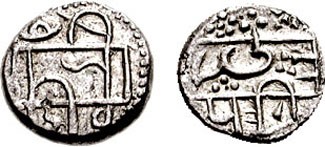
Shivaji (the great)
1674-1680 AD
Hon, Weight: 2.36 gms, Silver
Obverse: Legend in Devnagri `Shri Raja Shiva’.
Reverse: Legend in Devnagri `Chatrapati’. Reference: MW T1CNG Specimen, Triton XII, Lot 987 & Auction 73, Lot 1187
Rare
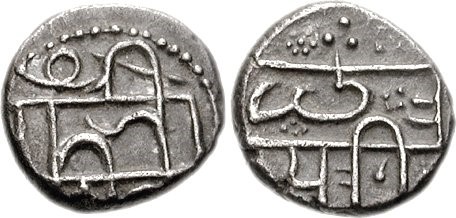
At this juncture, Aurangzeb sent Jaysingh, Raja of Amber (Jaipur), a brave but tactful general who had long military experience in many campaigns of empire. His foresight and diplomatic skills were far superior to other Mughal generals. After few brave attempts to save his territory, Shivaji concluded a peace treaty at Purandhar fort and on insistence of Jay Singh, agreed to pay visit to Aurangzeb at Imperial court of Agra. Shivaji was coldly received by Aurangzeb, which wounded Shivaji’s honor. He accused emperor of breach of faith whereupon he was imprisoned. He escaped from prison along with his son Prince Shambhuji and most of his colleagues (a fantastic episode!). Later shrewd Aurangzeb granted him title of Raja (king) and gave Vidarbha region of Maharashtra (Also called Berar).
On June 6th 1674, Gaga Bhutt, a learned priest from holy city Benaras, ceremoniously crowned Shivaji as a Chatrapti, a sovereign ruler. The detail description of coronation, celebrated with pomp and splendor is written by an English ambassador Oxenden, who attended crowning of Shivaji at his capital, Raygad. At this time the coins in gold (commonly known as Hon), silver and copper (known as Shivrai) were struck, which are unique. Most coinage circulating at this stage in entire Indian subcontinent were minted in the name of Mughal emperor and in the Persian script, however, Chatrapati Shivaji chose to strike coins in Devanagri script. These were/are special coins which denotes the complete title, Shri Raja Shiva Chatra Pati. His gold and silver coins are shown above.
Shivaji’s coronation laid the foundation of Maratha dynasty, which ruled major part of south-central India for next 2 centuries. Shivaji died bit prematurely at age of 50 in 1680 AD. At his death his kingdom consisted of almost whole of Maharashtra, Goa and Karnataka, and parts of Gujrat and Tamilnadu states of modern India.
Unquestionably, Shivaji was a daring soldier and a skilled military conqueror, but above all he was very successful ruler. According to most historians, he was a great administrator, meticulous organizer and a fine statesman. He looked after his kingdom with the help of a cabinet consisted of 8 ministers called Ashtapradhana. Historians believe that revenue administration of Shivaji was humane, efficient and was in interest of his subject. He organized a great Maratha army (remained strongest till the end of 18th century, the best proof of his military genius). He also built navy, which gave considerable trouble to English, Dutch and Portuguese navies.
In his private life, his moral virtues were exceptionally high. He was tolerant towards all the religions and records exist where he granted lands to Muslim shrines and Capuchin fathers (Christian monks). He had strict code for his army not to harm mosques, books of any religion and women. Both as a ruler and a man, Chatrapati Shivaji occupies a very distinguished place in Indian history.
Peshwas of Pune
Shivaji the great was followed by his two sons, Shambhuji and Rajaram, both ruled briefly. Brave Shambhuji fought gallantly with Mughals, but was captured by Mughal emperor Aurangzeb and was tortured to death. Rajaram kept the battle going, but died soon. The young son of Shambhuji, Shahu was made in charge of Marathas. Shahu turned out to be a smart ruler who appointed an intelligent Brahmin, Balaji Vishwanath as his Peshwa (prime minister). After death of Shahu, Marathas united under a confederacy and owed nominal allegiance to adopted son of Shahu and later kings. The Maratha confederacy which built the empire consisted of five families with Peshwas of Pune as the major power brokers. The other 4 families were Shindes (Scindhias) of Gwaliar, Gaikwars of Baroda, Bhonsale of Nagpur and Holkars of Indore. Shown below are coins issued by Peshwas at their capital Pune or Poona. Ankush, an elephant goad, a royal symbol of Peshwas is seen on obverse of coin, at 9 `o’ clock position.
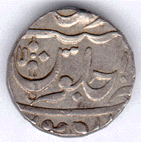
Peshvas of Pune
17th Century AD
Silver Rupee
Minted at Pune
Weight: 10.74 gm
Reference: KM#213
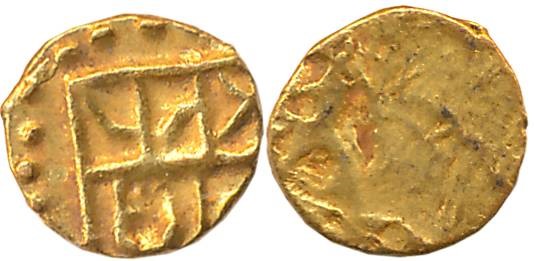
Peshavas of Pune
Weight: 0.2 gms, Gold, Fanam
Obverse: `Shri Pant Pradhan’ in Devnagri
Reference: Not in any Book, Similar to silver specimen of Wiggins & Maheshwari T2
Minted in 17 or 18th Century
Rare
Shinde/Scindhia of Gwalior
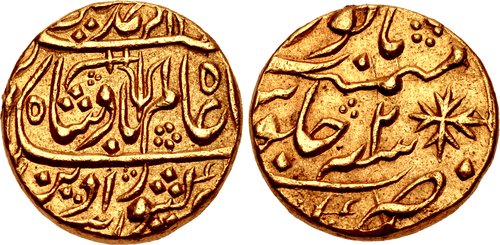
Mahadaji Shinde
Maratha dynasty of Gwalior
1768-1794 AD
In name of Mughal emperor Shah Ala II
Mohur, Weight: 10.7 gm, Gold
Obverse: `Sword and Trishul,’ Minted at Kora in 1761, Rgnal yr 2
Reference: Cf. KM#163 (rupee)
Uncirculated, Very rare
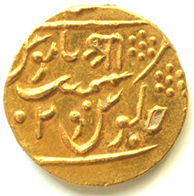

Baija Bai Shinde/Scindhia
Maratha dynasty of Gwalior
1827-1833 AD
In name of Mughal emperor Mh. Shah
Mohur
Weight: 10.80 gmGold
Obverse: `Shree’ written in Devnagri,’ representing Shree LaxmiMinted at Lashkar in 1130 AH, Rgnal yr 2
Reference: KM#126
Uncirculated
Scarce
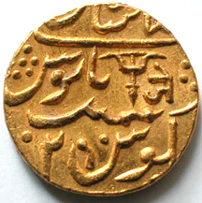
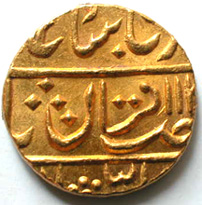
Jankoji Rao Shinde/ScindhiaMaratha dynasty of Gwalior1827-1843 AD or 1243-1259 AH In name of Mughal emperor Mh. ShahMohurWeight: 10.80 gmGoldObverse: `Je’ written in Devnagri, initial of ruler, Bow and arrow pointing downwardMinted at Lashkar in 113(0) AH Reference: KM#132 (upward bow) and 133 (downward)Choice Extremely Fine Scarce
Shinde or Scindhia were one of the five families that emerged as the major player during Peshava rule. They were generals in Maratha army and later carved out their own fiefdoms, which after fall of Peshavas became fully independent kingdom. Mahadaji Shinde was the greatest statesman of this dynasty, who first rose as a fine general and later established the dynasty rule from Gwalior. Mahadaji (also known as Madhoji) was primarily responsible for rebuilding Maratha military influence and prestige after disastrous, third battle of Panipat.
It was his daughter-in-law, Baija Bai, who single-handedly saved Gwalior state from British. Although childless, she adopted a boy from the same family and became regent till her adopted son Jankoji Rao took over the reign. Unfortunately, Jankoji Rao died in 1843, without any children. Interestingly enough, it was his widow Tarabai Raje Scindia took over and efficiently ruled the state. She too adopted a boy, Jayajirao, who became the next Maharaja of this prosperous princely state.
Shown above and below are the coins of these 3 rulers.
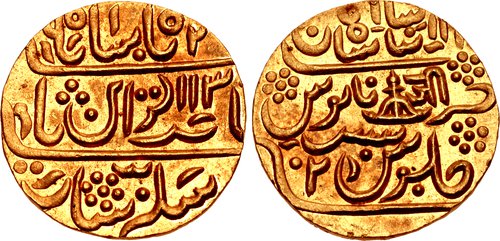
Jayaji Rao Shinde/Scindhia
Maratha dynasty of Gwalior
1843-1886 AD
In name of Mughal emperor Mh. ShahMohur,
Weight: 10.80 gm, Gold
Obverse: `Ji’ written in Devnagri, representing initial of ruler and bow-arrow pointing upward
Minted (at Lashkar? ) in fixed year of 113(0) AH,
Reference: KM#155
Uncirculated, Scarce
Holkars of Indore
Malhar Rao Holkar, a brave cavalryman who hailed from a very modest background, a family of Dhangars who are the goat/cattle herders. He worked with Baji Rao Peshva I, and later rose to be the Subedar (semi-independent ruler). He was granted all the territory north of Narmada river in 1728. This made Holkars ruler of significant part of the central India. As Peshva’s power waned, Holkars and Shinde became the most dominant Maratha powers, who essentially supported successive Mughal emperors. Shown below is a beautiful silver rupee of Malhar Rao Holkar, which was minted in the name of puppet Mughal emperor, Shah Alam II, who was under protection of the Maratha confederacy.
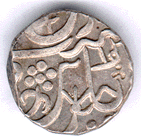
Malhar Rao Holkar
1728-1765 AD
Holkar of Indore
Silver Rupee
Minted at Chandor, year 12
Weight: 10.74 gm
Reference: KM#3.1
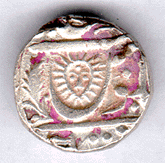
Yashwant (Jaswant) Rao Holkar
1798-1811 AD
Holkar of Indore
Silver Rupee
Minted at Indore, Sunface Emblem of dynasty
Weight: 11.24 gm
Reference: KM#
Malhar Rao married his son to a lady of extraordinary qualities, Ahilyabai. After death of her husband in battle and later her father-in-law to old age, she took over an an regent and carried on all the duties of the ruler with highest efficiency. Unfortunately, her son too died and she became the de-facto ruler of Indore kingdom.
Ahilyabai (ruled in 1767-1995 AD) was not only an able ruler and fine stateswoman, but also brave enough to lead her own armies. She was immensely popular among her subject due to her humane way of governance. In spite of being the queen of one of the wealthiest kingdom, in her private life she lived very simple and pious life, shunning all the luxuries. She was a great builder, and have re(built) numerous temples of India, many of them were ruined during earlier Mughal rule. One of the best example is the rebuilding of Kashi Vishwanath Temple at Varanasi (Benaras) nearby the original temple. The original temple was built during post-Gupta period, however destroyed by the order of Mughal emperor, Aurangzeb. The wall from the original temple is still part of the mosque (located at the back of the mosque), known as Gyanvapi mosque.
Maharaja Yashwantrao Holkar (also known as Jaswant rao Holkar) was the next significant ruler of this illustrious dynasty. A brave soldier who challenged supremacy of Peshawas. In 1802, Jaswant Rao Holkar finally defeated powerful Peshawas, ending their dominance in Maratha confederacy. He even defeated British army led by Col. William Monson. Later, lack of support from other Maratha chiefs lead to his defeat to British, although Holkars kept ruling the Indore state till 1947.
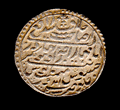
Jaswant Rao Holkar
1798-1811 AD
Holkar of IndoreSilver, Nazrana Rupee
Minted at Indore in 1807 AD (1222 AH)
Weight: 14.74 gm
Reference: KM#8
Bhonsale of Nagpur
Bhonsale ruled in central India with capital at Nagpur. Raghuji Bhonsale II was the last great king of this dynasty. He died in in 1816 and was succeeded by his imbecile son, Parsoji. His ambitious cousin Appa Sahib and Malhar Rao Holkar II rose in arms against British in the Battle of Sitabardi (Nagpur). They lost the war and large parts of their kingdoms was annexed. British established minor son of Raghuji II on Nagpur throne, who took the name as Raghuji III. He died without natural heir and thus `Doctrine of Lapse’ was applied by lord Dalhousie. Bhonsale lost the Kingdom and British took control of Nagpur state by 1853. Shown below is a nice example of the silver rupee minted by Raghuji Bhonsale III. The Maratha flag `Jaripataka’ is clearly seen on the reverse of coin (`F’ shaped in lower left corner on coin). This symbol, representing the dynasty was introduced only after 1825 AD. As usual this coin is very similar to the silver rupees of Mughals and minted in the name of puppet emperor, Shah alam II.
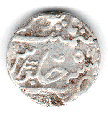
Raghuji Bonsale III
1816-1853 AD
Bhonsale of Nagpur
Silver Rupee
Minted at Katak in 1825-1853 AD
Weight: 11.3 gm
Reference: KM#17
Gaikwads of Baroda/Vadodara
A Maratha General of Peshvas of Pune, Pilaji Gaekwad conquered a fort at Songadh in modern Gujrath from Mughals and founded this dynasty in 1721. In course of time, this princely state became fabulously wealthy. The rulers of this state, especially Sayajirao III were able administrator and builder. His grandson Pratap Singh Gaekwad was the last ruling Maharaja of Baroda state. He founded the Maharaja Sayajirao (MS) University of Baroda, which remains one of the premier institution of higher learning in modern India. Shown below is his gold coin.
